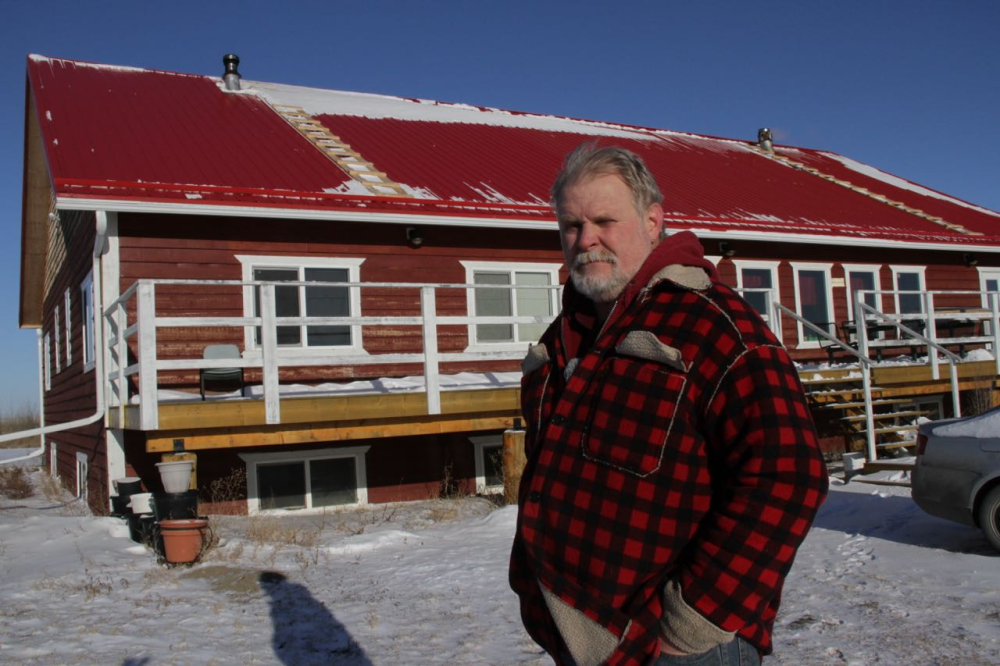About 10 years ago the town of Craik, Saskatchewan, was facing a problem common to so many rural centres on the prairie. The town was slowly dying. People were moving away to bigger cities and other provinces, and each census confirmed it.
That’s when the people of Craik hatched a plan that on the surface might seem a little crazy. They started an eco-village on the edge of town and sold plots of unserviced land for one dollar.
Orderly but dumb
 The movers and shakers behind the Eco-Village concept were local volunteers in the Craik Sustainable Living Project. Brent Kreuger came from Saskatoon to meet with them and after a meeting of the minds plopped down a dollar and bought in to the Craik Evo-Village concept.
The movers and shakers behind the Eco-Village concept were local volunteers in the Craik Sustainable Living Project. Brent Kreuger came from Saskatoon to meet with them and after a meeting of the minds plopped down a dollar and bought in to the Craik Evo-Village concept.
“We had to make a commitment to live, and build environmentally friendly,” says Kreuger. But beyond the local committee approving your plan to be environmentally friendly, there were no rulebooks, no prescriptions and no architectural guidelines.
This is pretty much the polar opposite of your standard orderly but dumb development pattern. Your typical new neighborhood is very pretty and planned but often over-engineered, inflexible and expensive. That orderly but dumb phrase was coined by Charles Marohn, the leader of a group called Strong Towns that advocates for creating financially resilient communities from within and over time.
In that spirit, Craik’s Eco-Village is more of a chaotic experiment in people finding ways to go green based on their own instincts, research, and experimentation. There are homes made out of straw bales, insulated concrete forms (ICF), sea cans buried underground and everything in between.
There is a mix of off-grid and on-grid homes, and small wind turbines dot the community landscape. It’s a delightful hodgepodge of green solutions when it comes to electricity, heating, water, sewage and building form.
Our unofficial tour guide is Krueger. He was the first Eco-Village resident to overwinter here and he runs the Praxis International Institute, a boarding school with a focus on entrepreneurialism and sustainability.
“Oh, we love it out here, we absolutely love it. We have our sense of community and that's something that I knew that we've lost. And I never really realized how much we've lost it until I came out here and found it again. One guy will start building a deck and all of a sudden three guys will show up with hammers,” says Krueger.
His house/school is built out of energy efficient insulated concrete forms (ICF). He calls it man-sized Lego, because it just snaps together — a simple, thermally efficient way to build a house. He’s got a wood pellet boiler, he captures waste heat from a walk-in cooler, has composting toilets and he collects his rainwater in cisterns for drinking and washing.
Community resilience
 The fact that this place exists at all is a testament to the scrappy, independent-minded, audacious people that the Eco-Village concept attracted. Craik Eco-Village residents Kelly and Audrey Taylor-Faye embody these traits best.
The fact that this place exists at all is a testament to the scrappy, independent-minded, audacious people that the Eco-Village concept attracted. Craik Eco-Village residents Kelly and Audrey Taylor-Faye embody these traits best.
They moved to Craik from the big city of Saskatoon with a dream of opening up a 7,000-square-foot straw bale retreat. The goal was to lure uptight big city folk to the country with workshops on pottery and photography. Unfortunately, halfway through building their dream facility, a huge windstorm blew down their building and wind turbine. The only thing left standing was their straw bale two-car garage, which now serves as a comfortable family home while they take a go-slow approach to rebuilding a scaled-down version of their retreat centre.
The Taylor-Fayes chose to go off-grid because the cost of installing their solar and wind and battery system was about the same as getting electricity into their home. But they did hook into Craik’s sewer system, which runs just past their property. They have a wood stove as their main source of space heating and a propane system for cooking and back-up heat.
It’s a lifestyle that doesn’t feel rustic to them at all.
“We kind of have to laugh because somebody that I was talking to on the phone had said, ‘Boy, I don't know how you guys do it. I can never go back to ancient ways like that,’" says Taylor-Faye.
“And when I hung up the cell phone, I looked around and our two kids and my wife were all on high-speed internet and the TV was going at the time and they were watching Netflix, and I was in the middle of steaming the milk for my latte in the morning and I thought, "Man, yeah, we really have it bad."
The best thing about Craik is that this crazy plan actually worked. Oh sure, it’s not the Norman Rockwell painting of an eco-community that members of the local committee may have envisioned, but the population is up. Craik is one of only two rural jurisdictions in Saskatchewan to see an increase in residents. Since 2005 the population of the town of Craik has risen by 11 per cent and the population of the surrounding rural municipality, which is where the eco-village actually sits, has increased by five per cent.
Not bad for a dollar.









